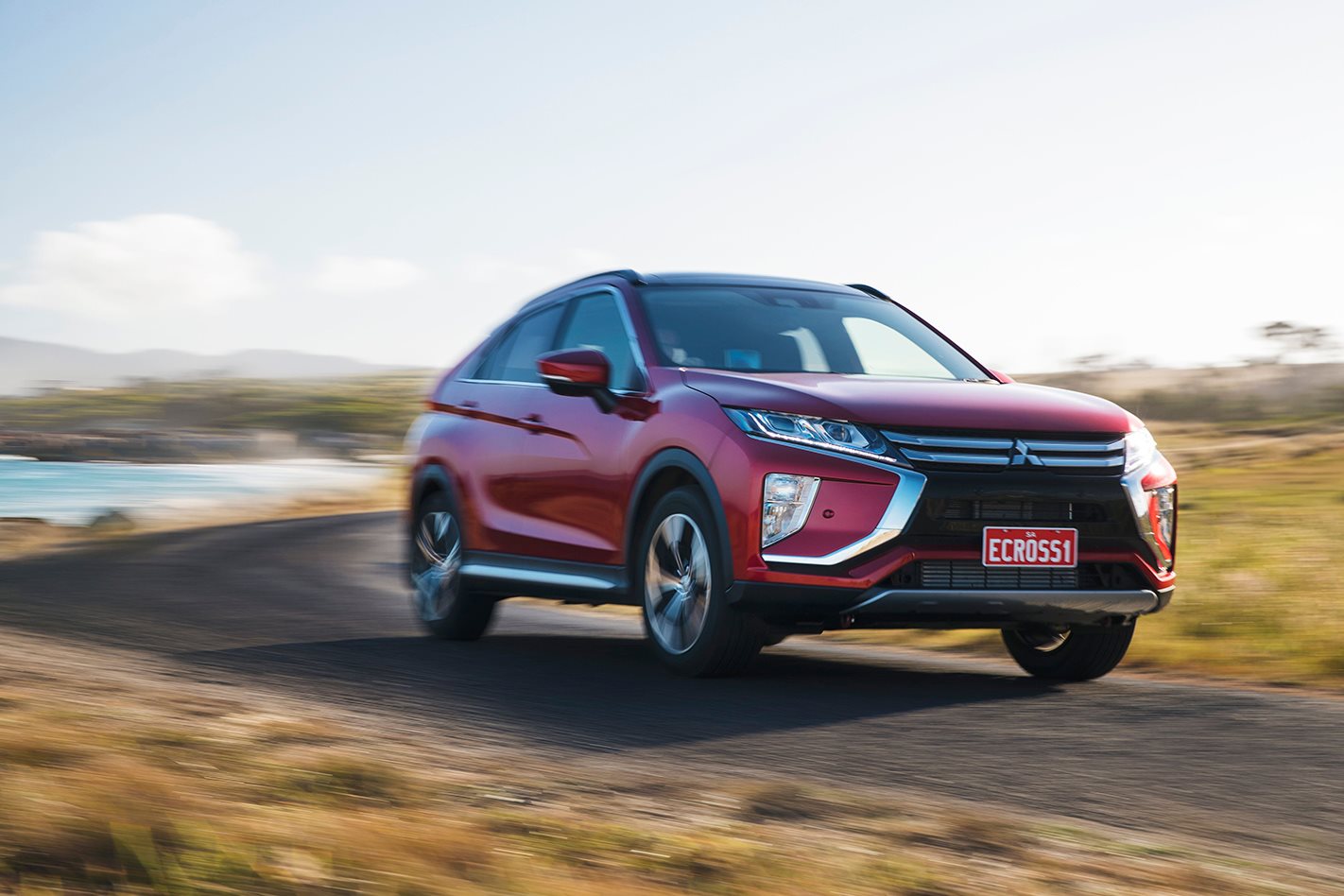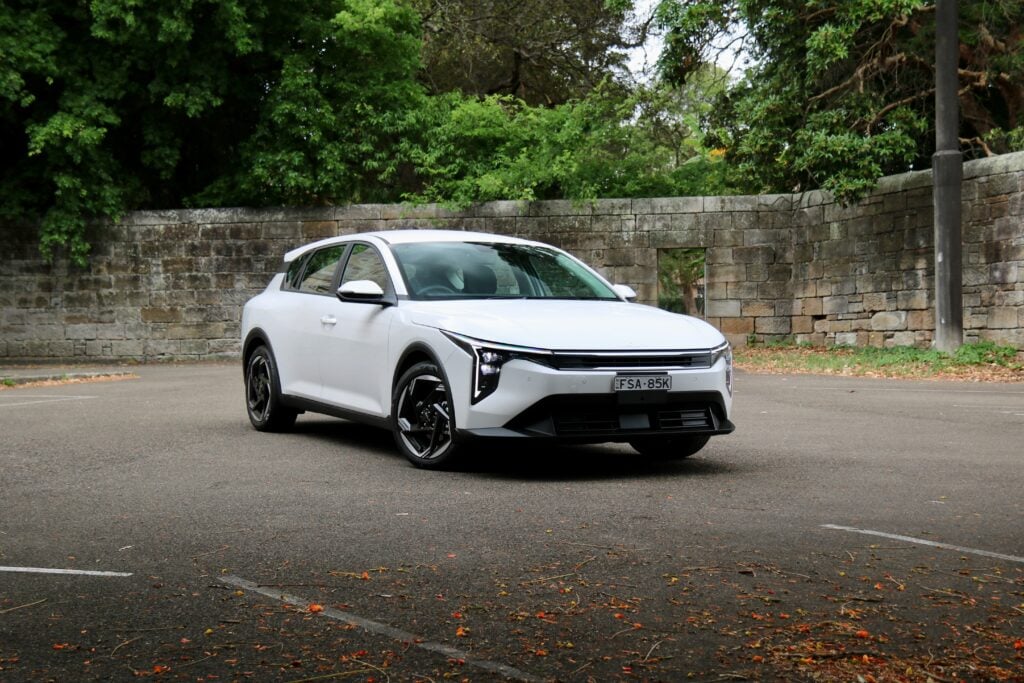
Score breakdown
Things we like
- Safety and equipment, rear seat flexibility, highway performance
Not so much
- Limp steering, poor rear vision, no diesel option
What stands out?
The Mitsubishi Eclipse Cross bridges the gap between the ASX and Outlander. It has a stylish, roomy cabin and decent standard equipment list that includes automatic emergency braking. All versions feature Mitsubishi’s latest infotainment package, and a 1.5-litre turbocharged petrol engine, coupled with a CVT automatic gearbox, with a choice of front- and all-wheel drive.
What might bug me?
Wishing the reversing camera could stay on all the time because of the limited rear vision caused by spoiler running across the tailgate window.The bruises on your forehead from bumping into the low rear door frame when strapping your kids into the Eclipse Cross.Driving at 80km/h on the space saver spare until you can fix your full-sized flat tyre.
What body styles are there?
Five-door SUV-type wagon only.There are front- and all-wheel-drive versions of the Eclipse Cross, which is classified as a small SUV, lower priced.
What features do all Eclipse Cross versions have?
- Cruise control, a reversing camera, leather-wrapped gearshift, and steering wheel with buttons for operating the cruise control, the sound system and your phone.
- A six-speaker sound system with AM/FM and digital (DAB+) radio receivers, USB input, Bluetooth connectivity for phone calls and audio streaming (with voice control), and at least four speakers controlled via a 7.0-inch touchscreen.
- Support for Apple CarPlay and Android Auto (via Mitsubishi’s Smartphone Link Display). Plug in a compatible smartphone and you can use some apps from the car’s central touchscreen – among them, navigation apps.
- Autonomous emergency braking.
- Height adjustment for the driver’s seat.
- Power folding door mirrors.
- Eighteen-inch wheels made from an aluminium alloy (which look good without plastic trim). A space-saver spare wheel.
- Daytime running lamps, illuminated by very long-lived LEDs and dusk-sensing headlights with automatic high-beam. Roof rails, which make it easier to fit rooftop luggage systems.
- Hill-start assist, which controls the brakes automatically to help you take off from rest on uphill slopes.
- Seven airbags. Anti-lock brakes, and electronic stability control – which can help control a skidding car. (For the placement of airbags, and more on Mitsubishi Eclipse Cross safety features, please open the Safety section below.)
- The Eclipse Cross is covered by a five-year, 100,000km warranty.
Which engine uses least fuel?
All Mitsubishi Eclipse Cross versions are powered by a 1.5-litre turbocharged (direct injection) petrol engine, which produces 100kW of power and 250Nm of torque.There is a choice of front- or all-wheel-drive traction. In front-wheel-drive it uses 7.3 litres/100km in official tests (city and country combined), which rises to 7.7 litres/100km with all-wheel-drive.The engine comes with a continuously variable transmission (CVT) automatic, which brings better performance and fuel economy than most conventional autos.(Power outputs and all other Mitsubishi Eclipse Cross specifications are available from the Cars Covered menu, under the main image on this page.)
What key features do I get if I spend more?
- The Eclipse Cross comes in three specification grades, ES, LS and Exceed, with the two pricier versions available with front-wheel-drive (FWD) and all-wheel drive (AWD) versions. The ES FWD is the least expensive Eclipse Cross.
- The ES FWD has all the features available in all Eclipse Cross versions, with standard cruise control and seats trimmed with cloth upholstery.
- Spending more on the LS FWD brings keyless entry, push button start, electric park brake that creates space for centre cupholders, front and rear parking sensors, rear-window wiper and washer, lane departure warning, dusk-sensing headlights, rain-sensing windscreen wipers, and a more streamlined panoramic 7.0-inch touchscreen.
- Stepping up to the Exceed FWD from the LS brings part leather trim, heated front seats and driver’s seat power adjustment.
- Adaptive cruise control, which automatically keeps a safe distance from the car travelling in front.
- LED headlights with auto levelling function, and dual-zone climate control, which lets the driver and front passenger set their own preferred temperatures.
- An electrochromatic rear-view mirror, which automatically dims to cut glare caused by headlights of cars behind you.
- The autonomous emergency braking also has ‘Ultrasonic Misacceleration Mitigation System’, which stops the Eclipse Cross hitting anything within four metres in front should you accidentally press the accelerator; for example a bollard or another car in front of a car parking space.
- Other additional active safety features include rear cross traffic alert, blind spot warning, and lane change assist, which sounds an audible warning when you indicate if there is a car on the side or directly behind your intended path.
- The LS and Exceed AWD versions drive all-four wheels for additional traction, and features ‘Super All Wheel Control’ which helps improve stability in corners during acceleration, deceleration and steady driving.
Does any upgrade have a down side?
Apart from the additional cost, not really. The most expensive Eclipse Cross, the Exceed AWD, uses a little more fuel than the front-wheel-drive versions; 7.7 litres/100km compared to 7.3/100km.White is the only standard colour; all other colours cost extra.
How comfortable is the Eclipse Cross?
Up front, the seats are supportive, storage is well considered, and the instruments clean and attractive. We’re unconvinced about the trackpad to control the multimedia and the lack of a volume knob, but the touchscreen compensates, and layout is otherwise mostly logical and intuitive.The chassis tune favours urban ride comfort, which is welcome, but the downside is significant roll into roundabouts. This less pronounced in the all-wheel-drive version, which features ‘Super All Wheel Control’ that helps improve stability in corners.Wind and tyre noise are well insulated for a small SUV.The spoiler across the rear window does nothing for rear vision, especially when you have backseat passengers.
What about safety?
Every Eclipse Cross has automatic emergency braking, lane departure warning, anti-lock brakes, stability control, a reversing camera, front and rear parking sensors, and LED daytime running lights (which make it easier for other drivers to see you) and seven airbags. In addition, all Eclipse Cross versions have dusk sensing automatic headlights and rain-sensing windscreen wipers.The LS and Exceed also have lane departure warning which alerts you if you stray over the line (a sign of driver fatigue).There are two airbags in front of the driver and front passenger; one outside each front seat to protect you at chest level from side impacts; a curtain airbag stretching down each side of the car at head level to protect front and rear passengers from side impacts; and finally an airbag to protect the driver’s knees.The Eclipse Cross Exceed adds rear cross traffic alert (which warns of any traffic or pedestrians approaching or behind you when reversing), blind spot warning, and lane change assist, which sounds an audible warning if you’re about to cut off another vehicle when you indicate to change lanes.The Australasian New Car Assessment Program (ANCAP) rated the Eclipse Cross safety at its maximum five stars, in December 2017.
I like driving – will I enjoy the Eclipse Cross?
The Eclipse Cross’s 1.5-litre four-cylinder, turbocharged petrol engine delivers respectable performance without being exciting. It accelerates well and the CVT auto does a job of maximising the propulsion available. Paddle shifters on the steering wheel allow you to take manual control of ‘gearing’.The chassis and suspension are tuned for urban roads. Eclipse Cross is predictable through bends, but leans significantly when cornering quickly, which sets up more dramatic movement from the body if you are faced immediately with a turn to the opposite side.Steering is a little limp, with a little movement in the steering wheel. On dirt roads it rattles and feels a little detached from the front wheels.Overall, though, the Eclipse Cross inspires confidence on country roads and freeways, and has a comfortable, elevated driving position.
How is life in the rear seats?
Small SUVs are not designed to transport lots of children, but the Eclipse Cross will fit three teens in the back seats in relative comfort. The coupe-esque profile and sloping roofline doesn’t unduly compromise rear headroom. The low door line, however, can make strapping kids into car seats a little difficult, and the upward slanting window line hampers smaller children’s side vision.The rear bench slides fore and aft by 200mm and offers useful backrest rake adjustment, and dedicated vents feed cooling or heating to the rear passengers.
How is Eclipse Cross for carrying stuff?
The 341-litre boot is relatively shallow, but can extend to 448-litres by sliding the rear seats forward 200mm. It has a wide opening that sits high off the ground and taller loads are limited by the raked forward tailgate. A 60:40 split-fold rear seatback adds to loading flexibility.Pockets in the front doors will cater for a large bottle and other odds and ends. But the centre console’s main open storage is in the twin cupholders. There is a covered binnacle under the central arm rest.The Eclipse Cross has a 1600kg braked towing capacity, which is good for a small SUV.
Where is the Eclipse Cross made?
All models of the Mitsubishi Eclipse Cross are produced in Japan.
Are there any rivals I should consider?
Funnily enough one of the Eclipse Cross’s biggest rivals is the Mitsubishi ASX. The Eclipse Cross is newer, slightly bigger and has plenty more standard features than the ASX, and it will be interesting to see how it fares against its older sibling, whose entry-level price is around $5000 less.Other rivals include the Mazda CX-3, Toyota C-HR, Hyundai Kona, Ford EcoSport, Suzuki Vitara, Suzuki-S Cross, Honda HR-V, Nissan Qashqai, and Kia Seltos.Mitsubishi is also positioning the Eclipse Cross against smaller medium-SUVs such as the Mazda CX-5 and Kia Sportage.
I like this car, but I can’t choose which version. Can you help?
There’s no compelling reason to go beyond the mid-spec Eclipse Cross, the LS. As well as a choice of front- or all-wheel-drive, it has a few extras over the ES for not much extra cost, and all the important standard features found in the Exceed, plus the same powertrain and performance.
Are there plans to update this model soon?
The Eclipse Cross arrived as a completely new model in December 2017.Mitsubishi introduced an Eclipse Cross ES in September 2018, as the new entry-level version, with about $1400 trimmed from the price by removing some features from the LS including keyless entry, push button start, electric park brake, front and rear parking sensors, and lane departure warning.The LS AWD was added to the range in September 2019 for the 2020 model year.Expect another slight update in the latter part of 2020.
Score breakdown
Things we like
- Safety and equipment, rear seat flexibility, highway performance
Not so much
- Limp steering, poor rear vision, no diesel option



